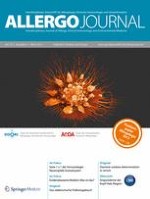13.04.2013 | Original Article
Diamine oxidase determination in serum
Low assay reproducibility and misclassification of healthy subjects
Erschienen in: Allergo Journal | Ausgabe 2/2013
Einloggen, um Zugang zu erhaltenSummary
Background:
Impaired histamine degradation based on reduced diamine oxidase (DAO) activity has been suggested to cause symptoms mimicking an allergic reaction.
Aim:
To test whether patients presenting with possible histamine-induced symptoms have a low serum activity of DAO compared to healthy subjects.
Methods:
Sera from 11 patients with a clinical history of potentially histamine-induced symptoms were included together with sera from 18 healthy subjects and 2 pregnant women having no such symptoms. The DAO activity in serum was quantified using a commercial enzyme immunoassay in three repeated measurements. A subset of sera was furthermore analyzed at a service laboratory.
Results:
Coefficients of variation between the three measurements of the individual sera were 5–138 %, with a mean of 35 %. The average deviation between the measured and the given value for a control sample included in the test kit was 86 %. Only 11 out of the 31 subjects were uniformly classified in all three runs. Among the healthy subjects, 9–12 out of 18 showed reduced or highly reduced activities; in the patient group, 0–5 out of 11 showed reduced or highly reduced activities in the three measurements. No significant differences were found between the healthy subjects and the patient group in two measurements, but one experiment surprisingly demonstrated a significantly lower mean level of activity, measured by histamine-degrading units (HDU/ml), for the healthy subjects. A subset of the sera were sent to a commercial service laboratory, and here too misclassification occurred. This could be due to reproducibility problems, since the same sample was divided into six aliquots and allocated into different classes in two of six cases.
Conclusion:
The high interassay variation and perhaps an incorrectly defined normal range caused misclassification in more than half of the cases. Using a commercial immunoassay, it was not possible to distinguish healthy subjects from patients showing potentially histamine-induced symptoms.












